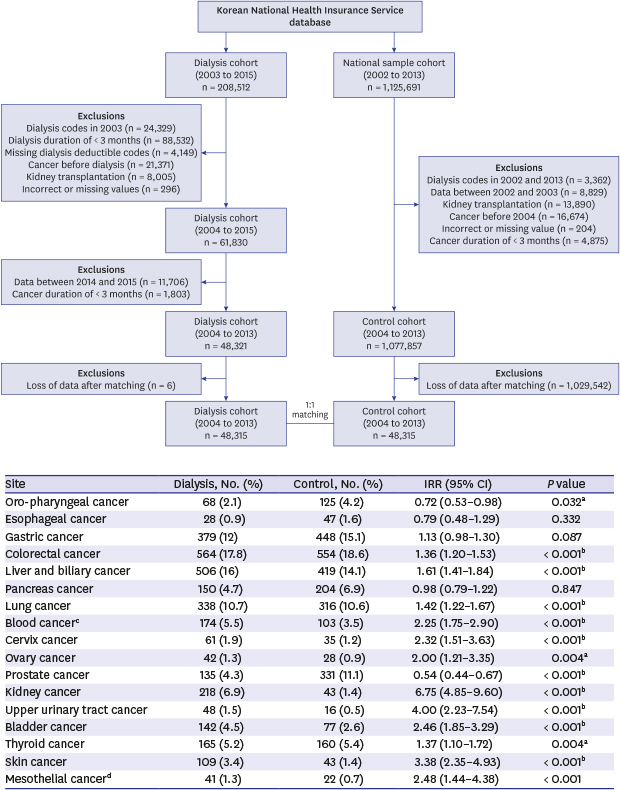1. Barlow WE. Overview of methods to estimate the medical costs of cancer. Med Care. 2009; 47(7):Suppl 1. S33–S36.

2. Min HS, Yang HK, Park K. Supporting low-income cancer patients: recommendations for the public financial aid program in the Republic of Korea. Cancer Res Treat. 2018; 50(4):1074–1083.

3. Meguid El Nahas A, Bello AK. Chronic kidney disease: the global challenge. Lancet. 2005; 365(9456):331–340.
4. Foster BJ, Mitsnefes MM, Dahhou M, Zhang X, Laskin BL. Changes in excess mortality from end stage renal disease in the United States from 1995 to 2013. Clin J Am Soc Nephrol. 2018; 13(1):91–99.

5. Wong G, Staplin N, Emberson J, Baigent C, Turner R, Chalmers J, et al. Chronic kidney disease and the risk of cancer: an individual patient data meta-analysis of 32,057 participants from six prospective studies. BMC Cancer. 2016; 16(1):488.

6. Stewart JH, Buccianti G, Agodoa L, Gellert R, McCredie MR, Lowenfels AB, et al. Cancers of the kidney and urinary tract in patients on dialysis for end-stage renal disease: analysis of data from the United States, Europe, and Australia and New Zealand. J Am Soc Nephrol. 2003; 14(1):197–207.

7. Lin HF, Li YH, Wang CH, Chou CL, Kuo DJ, Fang TC. Increased risk of cancer in chronic dialysis patients: a population-based cohort study in Taiwan. Nephrol Dial Transplant. 2012; 27(4):1585–1590.

8. Lin MY, Kuo MC, Hung CC, Wu WJ, Chen LT, Yu ML, et al. Association of dialysis with the risks of cancers. PLoS One. 2015; 10(4):e0122856.

9. Butler AM, Olshan AF, Kshirsagar AV, Edwards JK, Nielsen ME, Wheeler SB, et al. Cancer incidence among US Medicare ESRD patients receiving hemodialysis, 1996–2009. Am J Kidney Dis. 2015; 65(5):763–772.

10. Yoo KD, Lee JP, Lee SM, Park JY, Lee H, Kim DK, et al. Cancer in Korean patients with end-stage renal disease: a 7-year follow-up. PLoS One. 2017; 12(7):e0178649.

11. Lee J, Lee JS, Park SH, Shin SA, Kim K. Cohort profile: the National Health Insurance Service-National Sample Cohort (NHIS-NSC), South Korea. Int J Epidemiol. 2017; 46(2):e15.

12. Austin PC. A comparison of 12 algorithms for matching on the propensity score. Stat Med. 2014; 33(6):1057–1069.

13. Vamvakas S, Bahner U, Heidland A. Cancer in end-stage renal disease: potential factors involved -editorial-. Am J Nephrol. 1998; 18(2):89–95.
14. Maisonneuve P, Agodoa L, Gellert R, Stewart JH, Buccianti G, Lowenfels AB, et al. Cancer in patients on dialysis for end-stage renal disease: an international collaborative study. Lancet. 1999; 354(9173):93–99.

15. Wong G, Hayen A, Chapman JR, Webster AC, Wang JJ, Mitchell P, et al. Association of CKD and cancer risk in older people. J Am Soc Nephrol. 2009; 20(6):1341–1350.

16. Coussens LM, Werb Z. Inflammation and cancer. Nature. 2002; 420(6917):860–867.

17. Keith DS, Torres VE, King BF, Zincki H, Farrow GM. Renal cell carcinoma in autosomal dominant polycystic kidney disease. J Am Soc Nephrol. 1994; 4(9):1661–1669.

18. Weng PH, Hung KY, Huang HL, Chen JH, Sung PK, Huang KC. Cancer-specific mortality in chronic kidney disease: longitudinal follow-up of a large cohort. Clin J Am Soc Nephrol. 2011; 6(5):1121–1128.

19. Chen DP, Davis BR, Simpson LM, Cushman WC, Cutler JA, Dobre M, et al. Association between chronic kidney disease and cancer mortality: a report from the ALLHAT. Clin Nephrol. 2017; 87(1):11–20.

20. Cheung CY, Chan GC, Chan SK, Ng F, Lam MF, Wong SS, et al. Cancer incidence and mortality in chronic dialysis population: a multicenter cohort study. Am J Nephrol. 2016; 43(3):153–159.

21. Chuck KW, Hwang M, Choi KS, Suh M, Jun JK, Park B. Cancer screening rate in people with diabetes in the Korean population: results from the Korea National Health and Nutrition Examination Survey 2007-2009. Epidemiol Health. 2017; 39:e2017036.

22. Lee YJ, Choi SM, Lee J, Lee CH, Lee SM, Yoo CG, et al. Utility of the national lung screening trial criteria for estimation of lung cancer in the Korean population. Cancer Res Treat. 2018; 50(3):950–955.

23. Nam GE, Kim SM, Han K, Kim NH, Chung HS, Kim JW, et al. Metabolic syndrome and risk of Parkinson disease: a nationwide cohort study. PLoS Med. 2018; 15(8):e1002640.

24. D'Arcy ME, Coghill AE, Lynch CF, Koch LA, Li J, Pawlish KS, et al. Survival after a cancer diagnosis among solid organ transplant recipients in the United States. Cancer. 2019; 125(6):933–942.










 PDF
PDF Citation
Citation Print
Print






 XML Download
XML Download